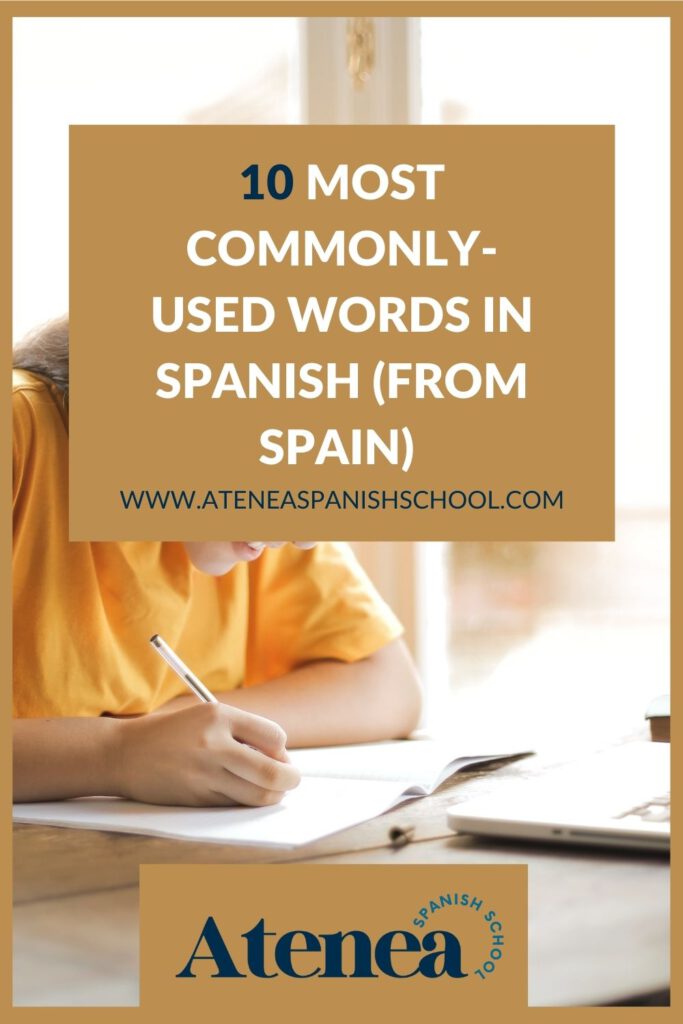In this article I will share with you the 10 most commonly-used words in Spanish (from Spain) so you will be able to understand conversations more easily.
Vale: It is one of the most used words in Castilian Spanish. You won’t be surprised to hear “vale” multiple times in a single conversation. It is used like the word “OK” in English.
Use nº1
To confirm that the listener agrees or has understood the message:
Voy a la playa esta tarde así que no estaré en casa ¿vale?
I’m going to the beach this afternoon so I won’t be home, okay?
Use nº2
To show agreement with the speaker.
¿Puedes llamarme más tarde?
Vale, sin problema.
Can you call me later?
Okay, no problem.
Use nº3
You can also say it twice to show more intensity.
Recuerda, tienes que ir a comprar pan, ¿vale?
Vale, vale. Iré.
Remember, you need to go and buy bread, okay?
Okay, okay. I’ll go.
Mono/mona: This word it is widely used in informal language to describe something that is cute, adorable or beautiful.
Tu vestido es muy mono.
El bebé es tan mono.
Ese mueble es mono, pero me gusta más aquel.
Your dress is very cute.
The baby is so cute.
This piece of furniture is cute, but I like that one better.
Venga: This verb comes from the verb “come” and is commonly-used in informal conversations in Spain.
Use nº1
You use it to cheer someone up:
Venga, tú puedes terminar eso sin problema. No te rindas.
Come on, you can finish that. Do not give up.
Use nº2
To express that you are in a hurry:
¡Venga! Tenemos prisa. No tardes.
Come on! We’re in a rush. Don’t be late.
Ya: This is another one of those words that you can hear countless times in a single conversation. “Ya” has quite a few uses and these are two of the most frequent ones in informal conversations.
Use nº 1
Means ‘already’ – the action has finished, or you have done it.
Ya he visto esa película.
I’ve already seen that movie.
Uso nº2
To express agreement (the connotation is not 100% affirmative), it can be deduced that the person is not very convinced.
Ese mueble es bonito.
Ya…
That piece of furniture is nice.
I know…
Bueno: You can use it as an adjective to describe something in a positive way, for example: Este pan es bueno (this bread is good). However, it has other different uses.
Use nº1
An equivalent of “okay” to express approval (although here “good” has a connotation of resignation or not being very convinced by the idea).
¿Vienes a mi casa?
Bueno…
Are you coming to my house?
Okay…
Use nº2
You will also find it at the beginning of a sentence, when you want to explain something.
Bueno, como te estaba diciendo…
Well, as I was saying…
Use nº3
In the middle of the conversation to clarify what you meant, or when you change your mind and want to rephrase the previous sentence.
Me gustaba más el helado de fresa, bueno, el de fresa y plátano estaba mejor.
I liked the strawberry ice cream better, well, the strawberry and banana ice cream was better than that one.
Claro: Apart from being an adjective that means “light” or”pale”, it also has other meanings.
Use nº1
To affirm a statement, especially for something that is considered obvious or natural.
¿Puedo ir a tu casa?
Claro, mi casa es tu casa.
Can I go to your house?
Of course, my house is your house.
Use nº2
It is used as an exclamation to say that something has finally been understood.
¡Claro! Ahora lo entiendo todo, esta tarta lleva canela, por eso no me gusta nada.
Of course! Now I understand, this cake has cinnamon in it, that’s why I don’t like it at all.
Entonces: This is a very useful and frequent connector in conversations.
Use nº1
Introduce a sentence indicating a deduction or a consequence of what was said previously or of something that has just happened. The translation is “so”.
El lavavajillas no funciona, entonces tendremos que lavar los platos a mano.
The dishwasher doesn’t work, so we’ll have to wash the dishes by hand.
Mira: this verb comes from the verb “to look”.
Use nº1
This expression is used at the beginning of the sentence to later give an explanation and express feelings.
Mira, me parece una actitud fantástica.
Look, I think that’s a fantastic attitude.
Mira, entiendo lo que dices pero no estoy totalmente de acuerdo.
Look, I understand what you’re saying, but I don’t totally agree.
Vamos: It comes from the verb “ir” (to go). “Vamos” is used in the present tense to explain movement actions in the plural (we go). Also, it is used in the following cases.
Use nº1
To encourage a person to do something or say that you are in a hurry.
¡Vamos! Tú puedes.
Come on! You can do it.
¡Vamos! ¡Vamos! O no llegaremos a tiempo.
Let’s go now! Or we won’t be on time.
Oye: This expression comes from the verb “oir” (to hear). “Oye” is used for the third singular person in the present tense, but you can use it in informal conversations too.
Use nº1
To grab someone’s attention, normally between friends and family. We recommend that you do not use it with strangers, it can be somewhat impolite.
Oye, el ayuntamiento no es por ahí.
Hey, the town hall isn’t that way.
Oye, ven aquí.
Hey, come here.

Do you have any question? Contact us to solve them in our free trial lesson.
Tell us in the comments if you knew these words or if you know others that do not appear in this post.



